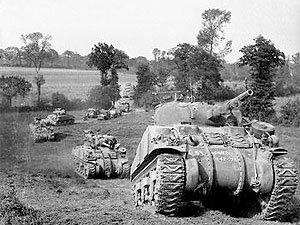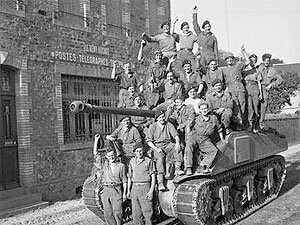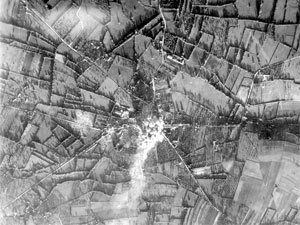The battle
Bluecoat - British progression
British position
 July 31, 1944 – an armoured column of the 2nd Irish Guards, Guards
July 31, 1944 – an armoured column of the 2nd Irish Guards, Guards
AD, progresses to the south of Caumont. © IWM B8276 Since the D-Day landings, the progression of the units of His Majesty George VI was somehow frustrating. On the right flank, US forces progressively extended their bridgehead by cutting isthmus of Cotentin and capturing the city and port of Cherbourg. Afterward, the Americans turned south, and after a bloody “hedgerows war” they captured Saint-Lô. Meanwhile, on the left wing, British and Canadian forces had progressed slowly; the northern bank of Orne River in Caen, which was the key D-day objective, was captured no sooner than on July 8th. It took ten additional days to hold the southern districts of the city.
This apparent slow progression deserves some justification. Hitler was conscious of the military value of the British divisions, and wished to keep Caen at all cost. He accumulated three-quarters of his elite units, the Wehrmacht and SS Panzer divisions, in front of the 2nd British Army. All major operations launched in this sector by Montgomery – Perch, Epsom, Charnwood, Jupiter and Goodwood, bumped into this obstacle. At the time of operation Epsom at the end of June, the 8th British Corps faced a massive counter-attack led by the whole 2nd SS-PanzerKorps, including 2nd, 9th, and 10th PzD. Such unequal distribution of enemy forces on the Normandy front had forced Allies to adapt their own strategy: while the British would take care of German forces in the sector of Caen, the Americans would be free to advance as far as possible to the west.
In accordance with this plan, once the breakthrough was obtained through operation Cobra, the British would prepare a large-scale attack in order to prevent the Germans from counter-striking in the still narrow and exposed corridor of Avranches. This operation, codenamed “Bluecoat”, aimed to protect the American left flank and push in direction of Villers-Bocage and Caumont. General Dempsey planned a traditional attack, including:
- to the west - the 8th Corps, composed of 11th Taurus Pursuant and Guards armoured divisions, and the 15th Scottish Infantry Division. Their objective was Vire;
- to the east, the 30th Corps together with the 7th Armoured Division Desert Rats, the 43rd Wessex and the 50th Northumbrian infantry divisions. Their target was Mount Pinçon.
This attack was to be coordinated together with advance of the 1st US Army (Hodges). While Patton and his 3rd Army penetrated in Brittany, Hodges progressed towards East, thus strengthening the corridor of Avranches; Villedieu was liberated on August 2nd and Mortain on the following day.
Two Army Corps in the battle
 August 1st, 1944 – standing on a Sherman Firefly, British soldiers
August 1st, 1944 – standing on a Sherman Firefly, British soldiers
cheers the capture of Le Bény-Bocage. © IWM B8343 Operation Bluecoat was launched in the morning of July 30, 1944. The action of the 15th Scottish Infantry Division, which was leading the attack of the 8th Corps, was initially delayed by in-depth enemy defenses. After managing to overcome the defenders, the infantry progressed in direction of the Hill 309. On the way, the 6th Guards brigade acting as armoured support to 15th Scottish, suffered the counter-attack by three Jagdpanthers of the s. PanzerJager Abt. 654. It managed to repulse the attack but lost ten Churchill tanks in the battle.To the west, the 11th Armoured Division succeeded in seizing Saint Martin des Besaces on July 31. Fortune favours the brave: the bridge, unguarded by Germans, allowed the advanced divisions of the 2nd Household Cavalry to cross the Souleuvre River early afternoon.
Such fast progression started to create a breach in German defenses. To maintain a frontline, now threatened by integral collapse, General Von Kluge had no other alternative than to engage his last reserves, limited at the time to exhausted the 21st PzD. Amazingly, this division, which was fighting since June 6th, managed, in spite of its weakness, to organize improvised defensive positions and slow down the advance of the British Guards Armoured Division, which was recently engaged in the operation on the south of Saint Martin des Besaces.
The situation was much less brilliant for the 30th Corps. The Germans had covered the expected axis of British attacks with large minefields, delaying the initial assault of 50th infantry division less than two kilometers from its starting line. Consequently, the 43rd Infantry Division was partially stopped short of Cahagnes. In a hurried attempt to resume his offensive, Bucknall, the commander of the 30th Corps, prematurely engaged the 7th Armoured Division (British Desert Rats), which entangled with the traffic of rearguard of the 43rd Infantry Division, who were also using the same roads. Subsequently, in spite of virtually inexistent enemy opposition, the 30th Corps was able to crawl along by no more than couple of kilometers. Worse, on August 3rd, a counter-strike of the 10th SS-PzD, stopped the Desert Rats on their starting positions.
In spite of some local success of the 43rd Infantry Division, which captured Jurques, the last failures of the leading armoured division exasperated Montgomery, and resulted in relieving Bucknall and Erskine (commander of the 7th armoured division) of their commands. These radical changes did not bring positive results immediately. No sooner than on August 5th, the 1st Tank Regiment finally reached the Aunay sur Odon, which was now in ruins. The following day, the 43rd Wessex Division launched its assault on Mount Pinçon, but was soon stopped by the heavy fire of German machine-guns. Losses were heavy until a discovery of an unguarded path allowed 13/18th Hussars to gain a foothold on the plateau on top of the hill, where the infantry of Wessex joined in (or: allowed Hussars to open the way to the top of the hill, where the infantry of Wessex joined it.
 August 1944 - bombing of Aunay sur Odon. One can observe
August 1944 - bombing of Aunay sur Odon. One can observe
around the city the thick Norman bocage. © CR Basse Normandie
- National archives USA
In front of the 8th Corps, a capture of the bridgehead on the Souleuvre made possible to develop the offensive. On August 2nd, an armoured column of the 11th Armoured Division (23rd Hussars, 3rd RTR and 4th Shropshire) advanced towards Le Désert and Presles, where it encountered a strong resistance of the 9th SS-PzD. A second column (Fife and Forfar, 3rd Monmouthshire) went in direction of Burcy and reached Pavée at dusk. This expansion of the front allowed Dempsey to throw in the battle the 3rd British Infantry Division, which was recently transferred from Caen. From now on, the battle-hardened Ironsides, in alliance with the Americans, would advance and secure the left flank of the 8th Corps.
German counter-attacks were conducted mainly by 9th and 10th SS-PzD, but also by completely heteroclite elements such as Mongolian Osttruppen battalions. In spite of the counter-attacks, the already sized targets remained in the British hands. Still in the lead, the Taurus Pursuant liberated the village of St Charles on August 5th, at the price of ten destroyed tanks. Since the capture of Vire have finally been entrusted to the Americans, the 8th Corps would prolong its offensive in direction of Condé-sur-Noireau and Flers, with the 30th US Infantry Division moving from now on towards Thury-Harcourt.

Although, the push on Brittany was costly and partially overshadowed by the Americans, the progression of O' Connor was one of many major successes achieved by the British forces in Normandy. First, it efficiently tied down the German forces facing north and denied them any possibility to immediately threaten the breach of Avranches. Secondly, it made Von Kluge to engage its last reserves, and, in preparation of forthcoming counter-attack on Mortain, to withdraw its troops behind the Orne up to Thury-Harcourt. The 12th Corps would be the first to take advantage of this move. On August 4th, its 53rd and 59th infantry divisions would advance and capture the Hill 112 and Villers-Bocage, both which were unattainable objectives of many attacks launched in the previous month.
At the end of the first week of August, the strategic axis of the British effort moved to the east. When Operation Bluecoat finally stalled on August 6th, after having definitely lost its momentum in front of resolute enemy opposition, the Americans had largely circumvented the German front and approached Le Mans. It appeared progressively that rather than continuing pushing the Germans back, it could be possible to capture the enemy before it could retreat and cross the Seine. The idea to lure the German 5th and 7th armies into a trap started to appear among in the top allied commanders …













 www.evl.pl
www.evl.pl